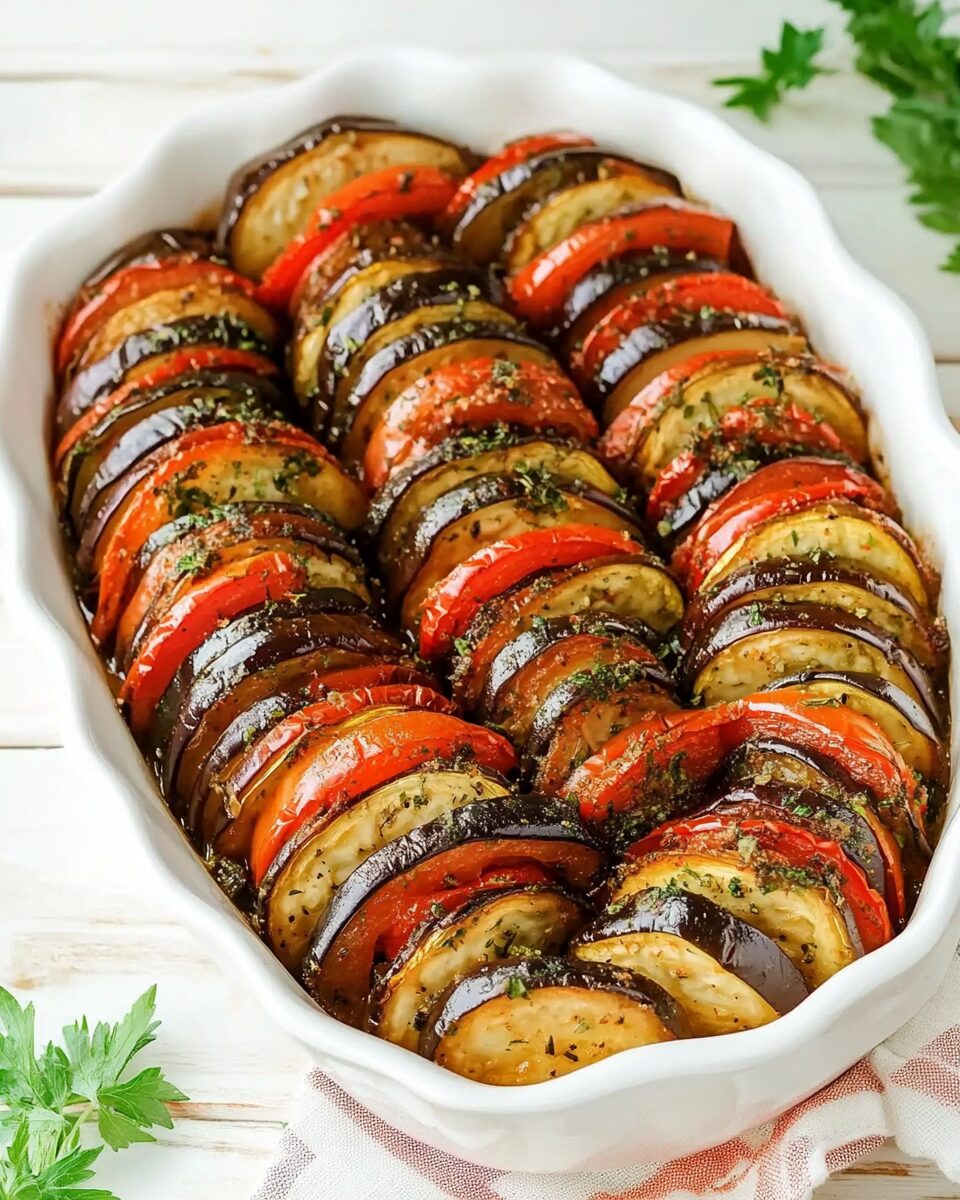A Timeless Dish with Deep Regional Roots
Originating from the Provence region in southeastern France, ratatouille is a dish born from the earth. Traditionally made during the summer harvest, it was a way for families to use up a bounty of fresh vegetables—particularly zucchini, tomatoes, eggplant, and peppers. The name “ratatouille” comes from the French word touiller, meaning “to stir up,” though the modern version often features a meticulously layered, baked presentation inspired by culinary artistry.
This dish has gained international recognition not only for its taste and versatility but also for its symbolism. It has become a shining example of how seasonal produce, when handled with care and enhanced with olive oil and herbs, can result in something extraordinary.
Visual Beauty Meets Nutritional Power
One of the standout features of this ratatouille recipe is its vibrant visual appeal. With concentric layers of colorful vegetables fanned out in a circular pattern, it’s as pleasing to the eye as it is to the palate. Each ingredient contributes its own flavor and texture, blending into a unified, aromatic whole during the slow roasting process.
Beyond the aesthetics, this dish is loaded with health benefits. Eggplant provides antioxidants and fiber, zucchini and squash offer hydration and vitamins, tomatoes deliver lycopene for heart health, and peppers bring a powerful boost of vitamin C. Together, they create a low-calorie, high-fiber meal that’s naturally vegan, gluten-free, and incredibly satisfying.
The Role of Herbs and Olive Oil
What elevates ratatouille from a simple vegetable medley to a Provençal delicacy is the infusion of olive oil and herbs. Olive oil acts not only as a carrier of flavor but also helps the vegetables roast evenly and develop a luxurious mouthfeel. The traditional French herb blend—herbes de Provence—typically includes rosemary, thyme, oregano, and basil. These herbs evoke the warmth and fragrance of the Mediterranean coast, adding a savory depth that lingers in each bite.
Garlic and tomato paste, layered beneath the vegetables, anchor the dish with a rich base that caramelizes slightly as it bakes, releasing subtle umami notes. It’s a reminder that in French cuisine, restraint and respect for ingredients are key.
Flexible and Meal-Prep Friendly
Ratatouille’s adaptability makes it one of the most practical dishes in any kitchen. It can be served warm, room temperature, or even chilled. As a result, it’s a fantastic option for meal prep, as the flavors only deepen and improve after a day or two in the refrigerator.
Serve it as:
-
A main course with crusty bread or over grains like couscous, farro, rice, or quinoa
-
A side dish alongside roasted chicken, grilled fish, or baked tofu
-
A topping for polenta, pasta, or savory crepes
-
A filling for wraps or sandwiches with goat cheese or hummus
-
A brunch centerpiece, topped with a poached egg or served with a chilled rosé
Best of all, it freezes beautifully—so don’t hesitate to double the recipe and save some for later.
Why Oven-Baked Ratatouille is Superior
While traditional ratatouille is often cooked on the stovetop with each vegetable sautéed separately to maintain texture, this oven-baked version is not only more convenient, but it also allows the vegetables to gently roast in their own juices. The result? A harmonious, melt-in-your-mouth texture with concentrated flavors and an irresistible roasted aroma.
Oven baking also makes it easier to control moisture, avoiding the mushiness that sometimes plagues stovetop versions. And with its stunning arrangement, this technique turns everyday vegetables into a dish worthy of a dinner party centerpiece.
Ideal for Entertaining and Special Occasions
Thanks to its elegant presentation, ratatouille makes a gorgeous addition to any table, whether you’re hosting a casual summer get-together or celebrating a special holiday. The layering process, while simple, creates a dish that looks far more complex than it actually is—giving you all the culinary credit with minimal stress.
Plus, it suits a wide range of diets and preferences, making it an inclusive choice for guests with dietary restrictions. It’s vegetarian, can be made vegan, and is completely gluten-free without sacrificing flavor or satisfaction.
Tips for Perfect Ratatouille Every Time
-
Slice vegetables uniformly to ensure even cooking. A mandoline slicer is ideal for this.
-
Use firm, ripe vegetables that hold their shape. Avoid overly ripe tomatoes or soft zucchini.
-
Let it rest after baking. Like many stews and roasted dishes, ratatouille tastes even better after it’s had time to cool and the flavors have mingled.
-
Don’t skip the garnish. A sprinkle of fresh basil or parsley right before serving adds color and a pop of freshness.
-
Layer your seasonings. Taste each element (especially the tomato paste base) to make sure it’s well seasoned before assembling.
Conclusion
This Classic French Provençal Ratatouille is a dish that proves simplicity and beauty can coexist. Rooted in tradition and refined through generations of home cooking, it’s a celebration of seasonal vegetables, bold flavors, and the timeless appeal of rustic French cuisine. Whether you’re a longtime lover of Mediterranean food or a curious first-timer, this ratatouille will win you over with its aroma, texture, and soul-warming flavor.
Perfect as a healthy weekday meal, a standout dinner party dish, or a thoughtful make-ahead option, ratatouille offers versatility, elegance, and comfort—all in one oven-baked masterpiece.

